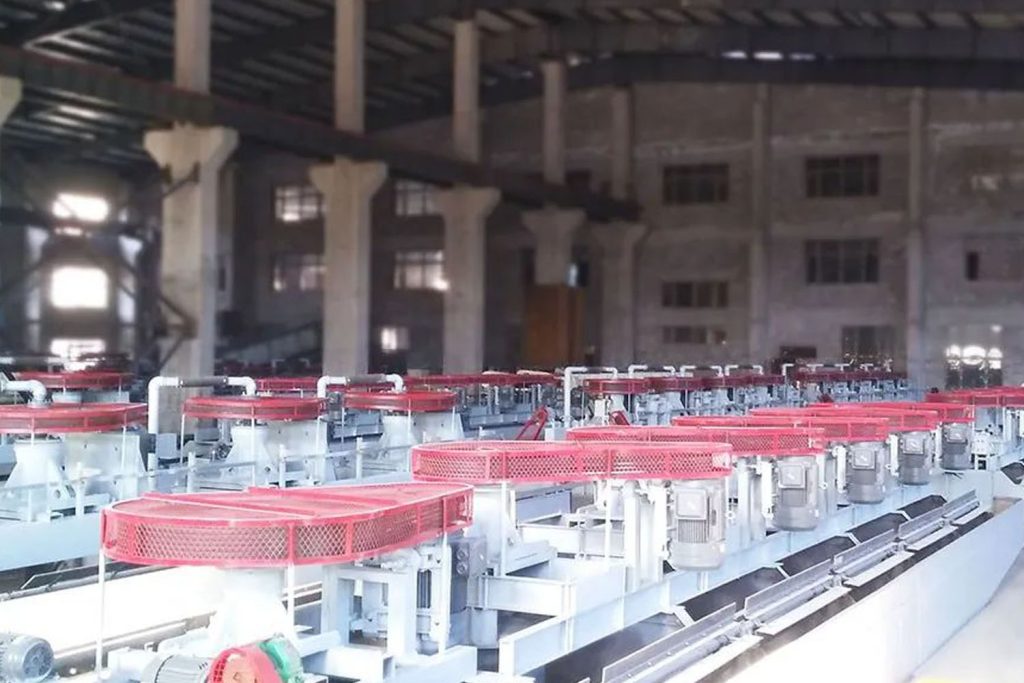Flotation is a process commonly used in gold ore concentrators. It is mainly suitable for sulfide gold-containing quartz vein ore with good buoyancy, processing polymetallic gold-containing sulfide ore and graphite-containing gold ore ore.
The three major technological processes of gold ore flotation
In the production process, the general gold ore flotation process mainly includes crushing and grinding operations, sorting operations and dehydration operations. In this article, we will start with different operation stages to understand the equipment needed for the gold ore flotation process.
Gold ore crushing and grinding operations
Whether gold can be recovered effectively depends mainly on the mineral properties of gold and the particle size distribution of gold. Therefore, crushing and grinding are very important. The raw ore enters the crusher for crushing and then enters the vibrating screen for screening.
The upper product is crushed again, and the crushed product is screened again. The product under the screen passes through the primary grinding. The grinding and grading equipment constitute a closed-circuit grinding. After classification, the grinding product Enter the second section of the ball mill for regrinding, and then form a closed-circuit grinding with the cyclone.
For gold sulfide minerals with good floatability, the monomer dissociation can be achieved by grinding to -75μm60~80%.
In crushing and grinding operations, generally medium and small gold dressing plants use two-stage and one closed-circuit crushing process, while large-scale gold dressing plants mostly use three-stage and one closed-circuit crushing process.
The jaw crusher is mostly used for coarse crushing, the cone crusher is used for medium or fine crushing operations, and the ball mill equipment is mostly used for the grinding stage. The grid-type ball mill is used for the first-stage grinding operation for coarse grinding, and the overflow-type ball mill is used for the second-stage grinding. Mining operations are finely ground.
Gold ore sorting operation
Flotation gold separation is mainly based on the difference in physical and chemical properties of the surface of mineral particles and the difference in mineral floatability.
The commonly used flotation processes mainly include single flotation, flotation-gravity separation, flotation-concentrate cyanide chemical, flotation-roasting-cyanidation process, etc.
Single flotation process
Single flotation is to first float gold into copper and sulfur concentrates, and then extract gold from these concentrates, so it is a more economical and reasonable process for gold ores containing ferrous metals in the original ore.
Single flotation can not only concentrate gold in sulfide minerals as much as possible, but also realize multi-metal comprehensive utilization. However, the final finished gold cannot be obtained, and it often forms a joint process with other mineral processing methods.

Flotation-gravity combined process
The technological process is that the raw ore is sorted by flotation to obtain the flotation concentrate, and the sulfide part in the flotation tailings often exists in the form of a conjoined body with the gangue.
In addition to being wrapped in sulfide with submicroscopic fine particles, gold often exists in the form of coarse-grained and fine-grained single gold.
Coarse-grained sulfide and gangue joints and coarse-grained natural gold in the tailings are difficult to recover by flotation, and part of the gold can be better recovered by gravity separation.
Flotation – concentrate cyanidation process
In this process, xanthate is generally used as collector, terpineol oil is used as foaming agent, and weak alkaline pulp is floated in a flotation machine to obtain gold concentrate.
Then the flotation concentrate is subjected to cyanide leaching, the gold is dissolved by cyanide, and the complex enters the solution, and then replaced with zinc powder to obtain gold mud, and finally the gold mud is pyro-smelted to obtain pure gold.
Flotation-roasting-cyanidation process
For flotation concentrates with high arsenic and sulfur content, after flotation of the cyanide tailings, impurities such as sulfur, iron, and arsenic are enriched into the concentrate to become refractory high-sulfur and high-arsenic concentrates, which cannot be directly cyanide During chemical leaching, the flotation gold concentrate can be oxidized and roasted first to remove arsenic and sulfur, so that the calcined sand structure after roasting is loose, which is more conducive to the leaching of gold and silver.
In the sorting operation, the commonly used flotation machines are mainly mechanical agitation flotation machines (SF type, JJF type, BF type), inflatable agitation type flotation cells (XCF type, KYF type) and flotation columns.
Among them, SF type, JJF type and XCF type are suitable for roughing and sweeping operations, KYF type and BF type are suitable for roughing and mineral processing operations, and flotation columns are mainly suitable for gold minerals with fine particle size and low density. It is rarely used in rock gold mines.

Gold mine dehydration operation
Generally, gold mine dehydration operation has two parts: concentrate dehydration and tailings dehydration. Concentrate dehydration needs to judge whether dehydration is required according to the process adopted in the concentrate operation, and the process mostly adopts the concentration filtration dehydration process. For tailings dewatering, a suitable dehydration process is customized according to the properties of tailings slurry.
Dehydration equipment commonly used in dehydration operations includes thickeners, filter presses, cyclones, etc. Among them, thickeners can be used for the first-stage dehydration of concentrate and tailings, and can also be used for pre-leaching concentration or leaching washing in cyanide plants. Cyclones and filter presses are mainly used for tailings dewatering operations.
In summary
The above is the introduction of gold ore flotation process and related equipment. However, not all gold ores are suitable for the flotation process. Gold ore resources are very precious. In order to select ores more reasonably, the mineral processing is very important. If you want to extract gold from gold ore in a more economical and environmentally friendly way, you should first conduct experimental analysis on the ore, and then customize the mineral processing that meets the situation through scientific and reasonable test reports to achieve an ideal return on investment.
